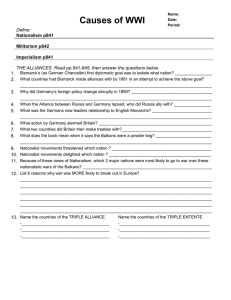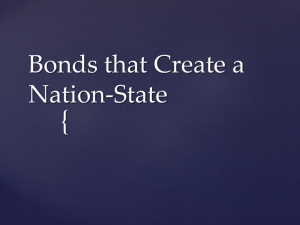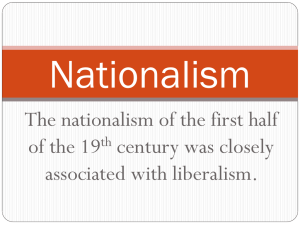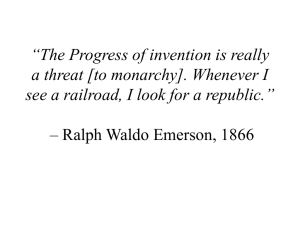Bell Ringer
advertisement
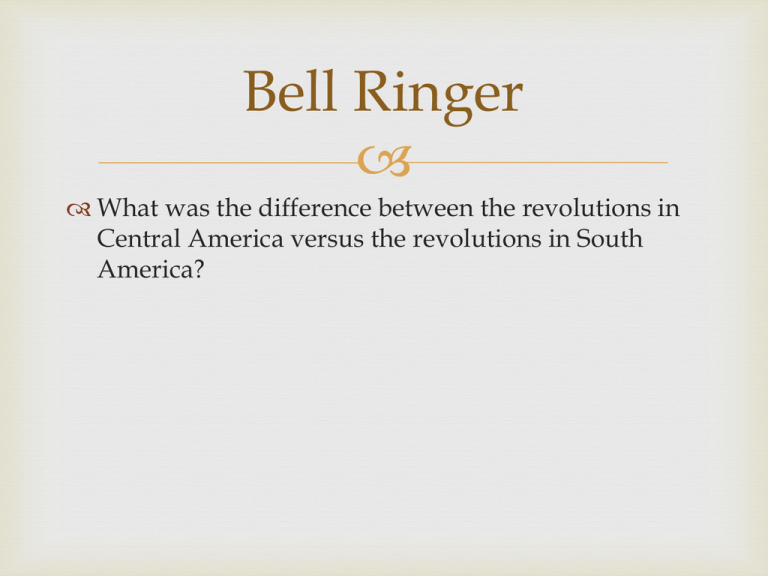
Bell Ringer What was the difference between the revolutions in Central America versus the revolutions in South America? Agenda/Objectives Nationalism: what does this term mean? What three groups were fighting for Europe? What is the idea of a Nation-State? Failed Revolutions. Nationalism in the United States. Stop! Think about it? The North and South American independence movements of the late eighteenth and early nineteenth centuries shared which of the following? A. Revolutionary demands based on Enlightenment political ideas. B. Reliance on Christian teachings to define revolutionary demands. C. Industrial economies that permitted both areas to break free of European control. D. Political instability caused by constant warfare among the new states. Nationalism Changes Europe 1800s: 3 groups struggled for supremacy in European Societies. - Conservatives - Liberals - Radicals Conservatives Usually wealthy property owners and nobility – argued for protecting the traditional monarchies of Europe. Certain cases: France, conservatives approved of constitutional monarchies. Liberals Mostly middle-class business leaders and merchants. - Wanted to give more power to elected parliaments, but only to parliaments in which the educated and the landowners could vote. Radicals Favored drastic change to extend democracy to the people as a whole. - practice ideas from the French Revolution. The idea of the NationState A new movement called Nationalism emerged. Nationalism - the belief that one’s greatest loyalty should not be to a king or an empire but to a nation of people who share a common culture and history. The idea of the NationState When the nation had its own independent government, it became a nation-state. Idea came from the French Revolution. Nationalism Sparks Revolts in the Balkans First people to win self- rule = Greeks Greece had been part of the Ottoman Empire. - Controlled most of the Balkans. Balkans: Greece, Albania, Bulgaria, Romania, and Turkey. Nationalism Sparks Revolts in the Balkans Greeks kept alive their ancient history and culture. Spurred by the nationalist spirit, Greeks demanded to become a nation-state. Revolts broke out in 1821. Greeks strongly supported around the world due to ancient history and culture. Nationalism Sparks Revolts in the Balkans 1823: Poet Lord Byron compared the nationalist movement to the Spartans. - donated money to the Greek fleet. 1824: died of a fever. 1827: British, French, and Russian fleet destroyed the Ottoman fleet at the Battle of Navarino. 1830: Britain, France and Russia signed a treaty recognizing the full independence of Greece. Reform in Western Europe Liberals and Nationalist openly revolted against Conservative governments. Liberal middle class leading the revolts: teachers, lawyers, and business people. Failed Revolutions 1830 – Belgians declared independence from Dutch control. Italian Nationalist work to unite the many separate states on the Italian peninsula. - independent or controlled by Austria or the pope. Austrian Prime Minister Metternich sent troops to restore order in Italy. Failed Revolutions Mid 1830’s Poland revolted from Russia. Took Russian armies an entire year to crush the rebellion. Many other failed attempts in Hungary, Germany, Czech, Budapest… By 1849, Most of Europe returned to Conservative rule. Nationalism in the U.S. How are we different from the rest of the world when it comes to national identity? How do you define yourself as an American? Peer Editing Please pass your paper to someone that you believe will give you the feedback you need on your paper.
